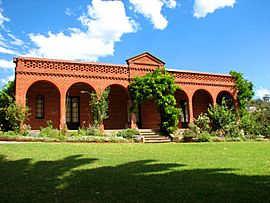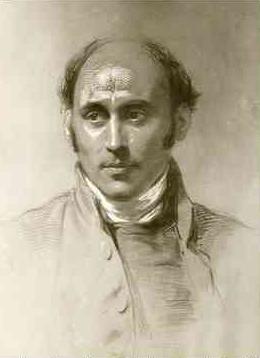Beaumont House facts for kids
Quick facts for kids Beaumont House |
|
|---|---|

The rear façade of Beaumont House
|
|
| General information | |
| Architectural style | Eclectic Romanesque-Classical |
| Town or city | Beaumont, South Australia |
| Country | Australia |
| Coordinates | 34°56′59″S 138°39′39″E / 34.94972°S 138.66083°E |
| Completed | 1851 |
| Client | Bp. Augustus Short |
|
South Australian Heritage Register
|
|
| Official name: 'Beaumont House', Stables, Shed and Olive Grove | |
| Designated: | 24 July 1980 |
| Reference #: | 10752 |
Beaumont House, sometimes known as Claremont, is a beautiful old brick house in Beaumont, South Australia. It has a mix of Romanesque and Classical styles. Beaumont House was built for Augustus Short, who was the first Anglican bishop (a church leader) in Adelaide. He also started St Peter's Cathedral.
The land where the house stands was first owned by Sir Samuel Davenport, a wealthy landowner in Adelaide. After Bishop Short moved back to England, Davenport bought the house. Beaumont House has had five owners in total. Since 1968, it has been looked after by the National Trust of South Australia. It was officially listed on the South Australian Heritage Register on July 24, 1980.
Contents
History of Beaumont House
The area of Beaumont, which is part of the City of Burnside, was created as a special village by Sir Samuel Davenport in 1848. Land in Beaumont was very expensive because it was close to Adelaide, a city that was growing quickly. Even though Adelaide was doing well in the mid-1800s, only a few people could afford to live in the exclusive Beaumont area.
Bishop Augustus Short's Arrival
Bishop Augustus Short came to Adelaide from England. The Archbishop of Canterbury (a very senior church leader) gave him a choice between moving to Newcastle or Adelaide. Both were new church areas. Bishop Short chose Adelaide. He became a bishop at Westminster Abbey in London on June 29, 1847. He then arrived in Adelaide by ship on December 28, 1847.
Building Beaumont House
Bishop Short wanted to live in Beaumont. He was rich enough to buy a large piece of land from Sir Samuel Davenport. Between 1849 and 1851, Beaumont House was designed and built for him. It was located on a large plot at the end of Glynburn Road. This road was important for Beaumont and connected to bigger roads leading into Adelaide. Bishop Short named his new home 'Claremont'. He chose this spot in the foothills of the Mount Lofty Ranges because it would catch cool breezes from the sea across the Adelaide Plains.
Bishop Short and his family moved into Beaumont House in 1851. They lived there until 1856, when their new home, Bishop's Court in North Adelaide, was ready. In the same year, Sir Samuel Davenport bought Beaumont House and its land from Bishop Short. Davenport lived in a small cottage called 'The Lodge' near the entrance to the Beaumont House driveway until Short moved out.
Bishop Short's Later Life
Bishop Short later started St Peter's Cathedral, an Anglican church, in 1869. Over the next thirteen years, his health declined, and he had disagreements with others. He stepped down as bishop in 1872 and as head of the church area in 1881. He returned to England on January 7, 1882. At that time, the Claremont estate was worth about £8200.
Sir Samuel Davenport was interested in growing olives. After he bought the land in 1851, he planted some olive trees around Beaumont House in 1852. He later planted more olive trees and cuttings from Beaumont at his other properties in the Adelaide Hills. He also planted mulberry trees on the estate to produce silk.
Davenport lived in Beaumont House until he passed away on September 3, 1906. His wife had passed away earlier, and they did not have children. He left most of his property to his nephew, Howard Davenport. Both parts of the South Australian Parliament stopped their work for his funeral to honor his contributions.
New Owners and the National Trust
In 1907, the estate was sold to a new owner, Major Vincent, who made many changes to the house. Then, in 1911, it was bought by Mr. Bennet. After Mr. Bennet passed away, the house went to his wife. On August 24, 1968, Mr. Bennet's widow, who had remarried, and her new partner gave Beaumont House to the National Trust of South Australia. The National Trust now cares for the house.
House Design and Changes
Beaumont House originally had five bedrooms. It has been made much larger over time. Most of the big changes happened between 1907 and 1911, when Major Vincent owned it. Since it was given to the National Trust, it has not been changed much.
The house reminds people a lot of Romanesque architecture. This is mainly because of the changes Sir Samuel Davenport made to the house and grounds. A member of the National Trust explained that Davenport's travels influenced his style: "Samuel Davenport traveled a lot around the world. He was very involved in the world exposition movement. Every two years, there were big world expos happening in different cities. He would travel to every one of these expos... I'm sure that the influences he picked up in all of his travels are reflected here in Beaumont House."
The olive groves are no longer grown at Beaumont House. However, other important additions by Davenport that show the Romanesque style are still there. The house is sometimes called 'Mediterranean' in style. This is mostly because of its red Tuscan-style roof, the olive groves, and the pillars on the outside.
See also



